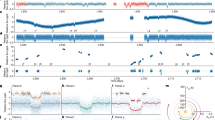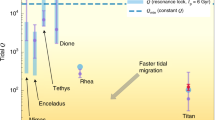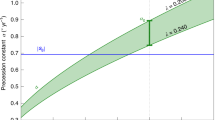Abstract
Surveys have revealed many multi-planet systems containing super-Earths and Neptunes in orbits of a few days to a few months1. There is debate whether in situ assembly2 or inward migration is the dominant mechanism of the formation of such planetary systems. Simulations suggest that migration creates tightly packed systems with planets whose orbital periods may be expressed as ratios of small integers (resonances)3,4,5, often in a many-planet series (chain)6. In the hundreds of multi-planet systems of sub-Neptunes, more planet pairs are observed near resonances than would generally be expected7, but no individual system has hitherto been identified that must have been formed by migration. Proximity to resonance enables the detection of planets perturbing each other8. Here we report transit timing variations of the four planets in the Kepler-223 system, model these variations as resonant-angle librations, and compute the long-term stability of the resonant chain. The architecture of Kepler-223 is too finely tuned to have been formed by scattering, and our numerical simulations demonstrate that its properties are natural outcomes of the migration hypothesis. Similar systems could be destabilized by any of several mechanisms5,9,10,11, contributing to the observed orbital-period distribution, where many planets are not in resonances. Planetesimal interactions in particular are thought to be responsible for establishing the current orbits of the four giant planets in the Solar System by disrupting a theoretical initial resonant chain12 similar to that observed in Kepler-223.
This is a preview of subscription content, access via your institution
Access options
Subscribe to this journal
Receive 51 print issues and online access
$199.00 per year
only $3.90 per issue
Buy this article
- Purchase on Springer Link
- Instant access to full article PDF
Prices may be subject to local taxes which are calculated during checkout



Similar content being viewed by others
References
Mullally, F. et al. Planetary candidates observed by Kepler. VI. Planet sample from Q1–Q16 (47 months). Astrophys. J. Suppl. Ser. 217, 31 (2015)
Hansen, B. M. S. & Murray, N. Testing in situ assembly with the Kepler planet candidate sample. Astrophys. J. 775, 53 (2013)
Melita, M. D. & Woolfson, M. M. Planetary commensurabilities driven by accretion and dynamical friction. Mon. Not. R. Astron. Soc. 280, 854–862 (1996)
Lee, M. H. & Peale, S. J. Dynamics and oigin of the 2:1 orbital resonances of the GJ 876 planets. Astrophys. J. 567, 596–609 (2002)
Terquem, C. & Papaloizou, J. C. B. Migration and the formation of systems of hot super-Earths and Neptunes. Astrophys. J. 654, 1110–1120 (2007)
Cresswell, P. & Nelson, R. P. On the evolution of multiple protoplanets embedded in a protostellar disc. Astron. Astrophys. 450, 833–853 (2006)
Fabrycky, D. C. et al. Architecture of Kepler’s multi-transiting systems. II. New investigations with twice as many candidates. Astrophys. J. 790, 146 (2014)
Agol, E., Steffen, J., Sari, R. & Clarkson, W. On detecting terrestrial planets with timing of giant planet transits. Mon. Not. R. Astron. Soc. 359, 567–579 (2005)
Cossou, C., Raymond, S. N., Hersant, F. & Pierens, A. Hot super-Earths and giant planet cores from different migration histories. Astron. Astrophys. 569, A56 (2014)
Pu, B. & Wu, Y. Spacing of Kepler planets: sculpting by dynamical instability. Astrophys. J. 807, 44 (2015)
Chatterjee, S. & Ford, E. B. Planetesimal interactions can explain the mysterious period ratios of small near-resonant planets. Astrophys. J. 803, 33 (2015)
Levison, H. F., Morbidelli, A., Tsiganis, K., Nesvorný, D. & Gomes, R. Late orbital instabilities in the outer planets induced by interaction with a self-gravitating planetesimal disk. Astron. J. 142, 152 (2011)
Borucki, W. J. et al. Characteristics of planetary candidates observed by Kepler. II. Analysis of the first four months of data. Astrophys. J. 736, 19 (2011)
Lissauer, J. J. et al. Architecture and dynamics of Kepler’s candidate multiple transiting planet systems. Astrophys. J. Suppl. Ser. 197, 8 (2011)
Lissauer, J. J. et al. Validation of Kepler’s multiple planet candidates. II. Refined statistical framework and descriptions of systems of special interest. Astrophys. J. 784, 44 (2014)
Carter, J. A. et al. Kepler-36: a pair of planets with neighboring orbits and dissimilar densities. Science 337, 556–559 (2012)
Lopez, E. D. & Fortney, J. J. Understanding the mass-radius relation for sub-Neptunes: radius as a proxy for composition. Astrophys. J. 792, 1 (2014)
Lee, E. J. & Chiang, E. Breeding super-Earths and birthing super-puffs in transitional disks. Astrophys. J. 817, 90 (2016)
Lissauer, J. J. et al. A closely packed system of low-mass, low-density planets transiting Kepler-11. Nature 470, 53–58 (2011)
Goździewski, K. & Migaszewski, C. Multiple mean motion resonances in the HR 8799 planetary system. Mon. Not. R. Astron. Soc. 440, 3140–3171 (2014)
Adams, F. C., Laughlin, G. & Bloch, A. M. Turbulence implies that mean motion resonances are rare. Astrophys. J. 683, 1117–1128 (2008)
Masset, F. S., Morbidelli, A., Crida, A. & Ferreira, J. Disk surface density transitions as protoplanet traps. Astrophys. J. 642, 478–487 (2006)
Minton, D. A. & Levison, H. F. Planetesimal-driven migration of terrestrial planet embryos. Icarus 232, 118–132 (2014)
Ormel, C. W., Ida, S. & Tanaka, H. Migration rates of planets due to scattering of planetesimals. Astrophys. J. 758, 80 (2012)
Nelson, B. E. et al. An empirically derived three-dimensional Laplace resonance in the Gliese 876 planetary system. Mon. Not. R. Astron. Soc. 455, 2484–2499 (2016)
Goździewski, K., Migaszewski, C., Panichi, F. & Szuszkiewicz, E. The Laplace resonance in the Kepler-60 planetary system. Mon. Not. R. Astron. Soc. 455, L104–L108 (2016)
Raymond, S. N., Barnes, R., Armitage, P. J. & Gorelick, N. Mean motion resonances from planet-planet scattering. Astrophys. J. 687, L107–L110 (2008)
Moore, A., Hasan, I. & Quillen, A. C. Limits on orbit-crossing planetesimals in the resonant multiple planet system, KOI-730. Mon. Not. R. Astron. Soc. 432, 1196–1202 (2013)
Batygin, K. & Morbidelli, A. Dissipative divergence of resonant orbits. Astron. J. 145, 1 (2013)
Delisle, J.-B. & Laskar, J. Tidal dissipation and the formation of Kepler near-resonant planets. Astron. Astrophys. 570, L7 (2014)
Vogt, S. S. et al. HIRES: the high-resolution echelle spectrometer on the Keck 10-m Telescope. Proc. SPIE 2198, 362–375 (1994)
Coelho, P., Barbuy, B., Melndez, J., Schiavon, R. P. & Castilho, B. V. A library of high resolution synthetic stellar spectra from 300 nm to 1.8 μm with solar and α-enhanced composition. Astron. Astrophys. 443, 735–746 (2005)
Demarque, P., Woo, J.-H., Kim, Y.-C. & Yi, S. K. Y2 isochrones with an improved core overshoot treatment. Astrophys. J. Suppl. Ser. 155, 667–674 (2004)
Morton, T. D. isochrones: stellar model grid package. Astrophysics Source Code Library ascl:1503.010, http://ascl.net/1503.010 (2015)
Girardi, L., Groenewegen, M. A. T., Hatziminaoglou, E. & da Costa, L. Star counts in the Galaxy. Simulating from very deep to very shallow photometric surveys with the TRILEGAL code. Astron. Astrophys. 436, 895–915 (2005)
Quillen, A. C. Three-body resonance overlap in closely spaced multiple-planet systems. Mon. Not. R. Astron. Soc. 418, 1043–1054 (2011)
Carter, J. A. et al. KOI-126: a triply eclipsing hierarchical triple with two low-mass stars. Science 331, 562–565 (2011)
ter Braak, C. J. F. Genetic Algorithms and Markov Chain Monte Carlo: Differential Evolution Markov Chain Makes Bayesian Computing Easy. Report No. 010404 (revised) http://edepot.wur.nl/39477 (Biometris, 2005)
Veras, D. & Armitage, P. J. The dynamics of two massive planets on inclined orbits. Icarus 172, 349–371 (2004)
Huber, D. et al. Stellar spin-orbit misalignment in a multiplanet system. Science 342, 331–334 (2013)
Masuda, K., Hirano, T., Taruya, A., Nagasawa, M. & Suto, Y. Characterization of the KOI- 94 system with transit timing variation analysis: implication for the planet-planet eclipse. Astrophys. J. 778, 185 (2013)
Sing, D. K. Stellar limb-darkening coefficients for CoRot and Kepler. Astron. Astrophys. 510, A21 (2010)
Southworth, J., Bruntt, H. & Buzasi, D. L. Eclipsing binaries observed with the WIRE satellite. II. β Aurigae and non-linear limb darkening in light curves. Astron. Astrophys. 467, 1215–1226 (2007)
Southworth, J. Homogeneous studies of transiting extrasolar planets – I. Light-curve analyses. Mon. Not. R. Astron. Soc. 386, 1644–1666 (2008)
Brown, T. M., Latham, D. W., Everett, M. E. & Esquerdo, G. A. Kepler input catalog: photometric calibration and stellar classification. Astron. J. 142, 112 (2011)
Howell, S. B. et al. Kepler-21b: a 1.6 R Earth planet transiting the bright oscillating F subgiant star HD 179070. Astrophys. J. 746, 123 (2012)
Brown, T. M. et al. Las Cumbres Observatory Global Telescope network. Publ. Astron. Soc. Pacif. 125, 1031–1055 (2013)
Howell, S. B., Everett, M. E., Sherry, W., Horch, E. & Ciardi, D. R. Speckle camera observations for the NASA Kepler mission follow-up program. Astron. J. 142, 19 (2011)
Chambers, J. E. Mercury: a software package for orbital dynamics. Astrophysics Source Code Library ascl:1201.008, http://ascl.net/1201.008 (2012)
Williams, J. P. & Cieza, L. A. Protoplanetary disks and their evolution. Annu. Rev. Astron. Astrophys. 49, 67–117 (2011)
Lissauer, J. J. et al. Architecture and dynamics of Kepler’s candidate multiple transiting planet systems. Astrophys. J. Suppl. Ser. 197, 8 (2011)
Batalha, N. M. et al. Planetary candidates observed by Kepler. III. Analysis of the first 16 months of data. Astrophys. J. Suppl. Ser. 204, 24 (2013)
Acknowledgements
We thank A. Howard and G. Marcy for their role in obtaining spectra, and E. Agol, J. Lissauer, and J. Bean for comments on the manuscript. This material is based on work supported by NASA under grant numbers NNX14AB87G (D.C.F.), NNX12AF73G (E.B.F.) and NNX14AN76G (E.B.F.) issued through the Kepler Participating Scientist Program. E.B.F. received support from NASA Exoplanet Research Program award NNX15AE21G. D.C.F. received support from the Alfred P. Sloan Foundation. C.M. was supported by the Polish National Science Centre MAESTRO grant DEC-2012/06/A/ST9/00276.
Author information
Authors and Affiliations
Contributions
S.M.M. performed the photodynamic, stability, tidal dissipation and spectral evolution analyses and led the paper authorship. D.C.F. designed the study, performed TTV and Laplace-angle libration analysis, and assisted writing the paper. C.M. performed the migration analysis, assisted in initial data fitting and contributed to the writing of the paper. E.B.F. advised on the DEMCMC analysis and paper direction. E.P. and H.I. obtained and analysed the spectra. All authors read and edited the manuscript.
Corresponding author
Ethics declarations
Competing interests
The authors declare no competing financial interests.
Additional information
Kepler data are publicly available at http://archive.stsci.edu/kepler/.
Extended data figures and tables
Extended Data Figure 1 Spectroscopic fit of the Kepler-223 star.
A fit to Yonsei–Yale (Y2) evolution tracks (coloured lines) with 0.01-Gyr increments marked with filled circles. Colours correspond to mass with increments of 0.01 from 1.0
from 1.0 (orange) to 1.4
(orange) to 1.4 (darkest blue). Isochrones (grey lines) are over-plotted in 2-Gyr increments from 4 Gyr (darkest grey) to 10 Gyr (lightest grey) with filled circles every 0.01
(darkest blue). Isochrones (grey lines) are over-plotted in 2-Gyr increments from 4 Gyr (darkest grey) to 10 Gyr (lightest grey) with filled circles every 0.01 increment. One point is labelled for reference (Msun =
increment. One point is labelled for reference (Msun =  ). The best-fit (Teff, log(g)) value (black cross) and an ellipse (black) whose semi-major axes indicate 1σ uncertainties of each parameter found from spectral matching are indicated. The stars in this area of parameter space have evolved off the main sequence.
). The best-fit (Teff, log(g)) value (black cross) and an ellipse (black) whose semi-major axes indicate 1σ uncertainties of each parameter found from spectral matching are indicated. The stars in this area of parameter space have evolved off the main sequence.
Extended Data Figure 2 Long-cadence light curve for each planet, broken down by quarter (Q).
Data (black filled circles) are binned via a moving average to give the blue curve, to reduce the scatter relative to the horizontal red line indicating no signal. Each panel is centred on the transit times predicted using the linear ephemeris (T0 and P) of ref. 52 (vertical black lines), with the horizontal axis the time in days from the Eth predicted transit time. The box-and-whisker error bars indicate the best-fit mid-transit time and 1σ and 3σ uncertainties based on Δχ2 = 1 and Δχ2 = 9. χ2 values are computed by sliding an overall fit to the transit horizontally across the data and interpolating. Their offset relative to the linear ephemeris lines indicates the magnitudes of the TTVs.
Extended Data Figure 3 Laplace-angle librations detected by binning transits into quarters and assuming zero eccentricity.
a–c, Error bars show 1σ uncertainties based on Δχ2 = 1. Almost a full libration cycle of all angles is observed in the ~1,500-day observing window. The amplitude of oscillation in the four-body Laplace angle (ϕ3; c) is similar in amplitude to each of the individual Laplace angles (ϕ1, a; ϕ2, b). Because ϕ3 = −3ϕ1 + 2ϕ2, this amplitude could naively be expected to be much larger; however, ϕ1 and ϕ2 are closely related, owing to the four-body resonance of the Kepler-223 system, in contrast to two independent three-body resonances.
Extended Data Figure 4 Variation in Laplace angles for two 107-year-stable solutions.
a, The librating Laplace angles (ϕ1, red; ϕ2, blue) for a solution from the  DEMCMC posterior. Laplace angles librate over the entire 107 years. The orbital-period distribution in Extended Data Fig. 5 uses this model. b, Another solution from
DEMCMC posterior. Laplace angles librate over the entire 107 years. The orbital-period distribution in Extended Data Fig. 5 uses this model. b, Another solution from  , in which the inner Laplace angle (ϕ1; red) librates near the observed value initially, but begins switching chaotically between three different libration centres. This is not uncommon in the
, in which the inner Laplace angle (ϕ1; red) librates near the observed value initially, but begins switching chaotically between three different libration centres. This is not uncommon in the  DEMCMC posterior. Despite the initial constraint on the outer Laplace angle (ϕ2; blue), there are long periods of circulation with intermittent libration.
DEMCMC posterior. Despite the initial constraint on the outer Laplace angle (ϕ2; blue), there are long periods of circulation with intermittent libration.
Extended Data Figure 5 Orbital-period ratios of librating and non-librating solutions fitted to data.
a, c, e, The distribution of osculating period ratios for each neighbouring planet pair (Pc/Pb, a; Pd/Pc, c; Pe/Pd, e) over a randomly selected 4-year window in the first 104 years for two 107-year-stable parameter sets from the  DEMCMC posterior solution. The dotted histogram represents a solution that showed substantial periods of Laplace-angle circulation. The solid histogram represents a solution in which both ϕ1 and ϕ2 librate for 107 years. The blue vertical line indicates the empirical mean period; blue dashed vertical lines represent the highest and lowest quarter-to-quarter period measured. b, d, f, The same as in a, c, e, but over the entire 107-year interval.
DEMCMC posterior solution. The dotted histogram represents a solution that showed substantial periods of Laplace-angle circulation. The solid histogram represents a solution in which both ϕ1 and ϕ2 librate for 107 years. The blue vertical line indicates the empirical mean period; blue dashed vertical lines represent the highest and lowest quarter-to-quarter period measured. b, d, f, The same as in a, c, e, but over the entire 107-year interval.
Extended Data Figure 6 System stability as a function of mean planetary eccentricity.
The fraction of 500 random draws from the  posterior that survive for 107 years (crosses) and 106 years (squares) as a function of four-planet-mean eccentricity in bins of width 0.01. 1σ statistical uncertainties are included as vertical error bars on the crosses. Dotted lines indicate the two eccentricity limits for the planets used in
posterior that survive for 107 years (crosses) and 106 years (squares) as a function of four-planet-mean eccentricity in bins of width 0.01. 1σ statistical uncertainties are included as vertical error bars on the crosses. Dotted lines indicate the two eccentricity limits for the planets used in  : 0.175 (planets c and e) and 0.212 (planets b and d). Numbers represent the total number of draws in each eccentricity bin. The fraction of 107-year-stable systems falls sharply and is consistent with zero well below the eccentricity cuts imposed by
: 0.175 (planets c and e) and 0.212 (planets b and d). Numbers represent the total number of draws in each eccentricity bin. The fraction of 107-year-stable systems falls sharply and is consistent with zero well below the eccentricity cuts imposed by  .
.
Supplementary information
Supplementary Data
This file contains Supplementary Table Dataset 1, a tsv file of predicted transmit times for Kepler-223. Columns: [Transit_Number] \t [Time_(BJD-2454900)] \t [1-Sigma_Uncertainty_(d)]. Description: Transits times and errors are estimated from integrations of the randomly selected 107 year-stable chains from posterior. Transit times are listed quarterly (the nearest transit time every 3 months) and extend for 10 years past the end of the Kepler mission. The transits of each planet are given sequentially and indexed from 0 at BJD 2455700, the data epoch used in our fits. (TXT 10 kb)
Supplementary Data
This file contains the source code compressed into zip format. (ZIP 8 kb)
Supplementary Data
This file contains source data for Extended Data Table 1. (TXT 2 kb)
Supplementary Data
This file contains source data for Extended Data Table 2. (TXT 4 kb)
Supplementary Data
This file contains source data for Extended Data Table 3. (TXT 1 kb)
Rights and permissions
About this article
Cite this article
Mills, S., Fabrycky, D., Migaszewski, C. et al. A resonant chain of four transiting, sub-Neptune planets. Nature 533, 509–512 (2016). https://doi.org/10.1038/nature17445
Received:
Accepted:
Published:
Issue Date:
DOI: https://doi.org/10.1038/nature17445
This article is cited by
-
Conditions for Convergent Migration of N-Planet Systems
Celestial Mechanics and Dynamical Astronomy (2022)
-
An upper limit on late accretion and water delivery in the TRAPPIST-1 exoplanet system
Nature Astronomy (2021)
-
A giant impact as the likely origin of different twins in the Kepler-107 exoplanet system
Nature Astronomy (2019)
-
Order out of Randomness: Self-Organization Processes in Astrophysics
Space Science Reviews (2018)
Comments
By submitting a comment you agree to abide by our Terms and Community Guidelines. If you find something abusive or that does not comply with our terms or guidelines please flag it as inappropriate.



